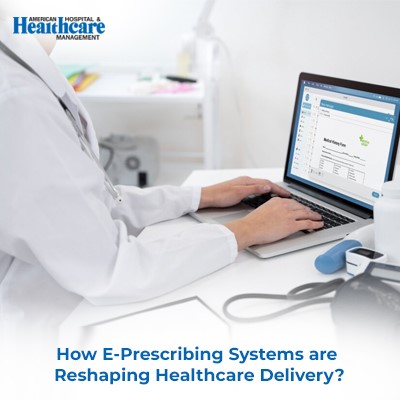E-prescribing systems revolutionize healthcare delivery by streamlining workflows, enhancing patient safety, improving medication adherence, enabling real-time monitoring, integrating with EHRs, and yielding cost savings. Challenges like implementation costs and data security must be addressed for widespread adoption, ensuring continued innovation and enhanced patient care globally.

The advent of e-prescribing systems marks a significant shift in the way healthcare services are delivered and managed. These digital solutions have emerged as essential tools for healthcare providers, pharmacies, and patients alike, offering a range of benefits that enhance efficiency, safety, and overall quality of care. As technology continues to evolve, the integration of e-prescribing systems with other digital health solutions is poised to further transform healthcare delivery models, driving innovation and improving patient outcomes.
1. Streamlining Prescription Workflow: E-prescribing systems streamline the prescription workflow by leveraging electronic platforms to transmit prescription information seamlessly between healthcare providers and pharmacies. This eliminates the need for paper-based prescriptions, which are prone to errors such as illegible handwriting or incomplete information. By digitizing the prescription process, healthcare providers can enter prescription details directly into the system, ensuring accuracy and reducing the likelihood of misinterpretation during transmission. Pharmacists receive electronic prescriptions instantaneously, allowing them to process medication orders efficiently and accurately. This streamlined workflow not only saves time but also enhances communication between healthcare teams and pharmacies, leading to improved patient care and satisfaction.
2. Enhancing Patient Safety: One of the primary goals of e-prescribing systems is to enhance patient safety by reducing medication errors and adverse drug events. These systems incorporate advanced clinical decision support tools that analyze patient data, including medical history, allergies, and current medications, to identify potential risks and interactions. Healthcare providers receive real-time alerts and notifications regarding drug allergies, dosage discrepancies, or contraindications, enabling them to make informed prescribing decisions. Additionally, e-prescribing systems facilitate communication between healthcare providers and patients, allowing for discussions about medication instructions, potential side effects, and adherence strategies. This proactive approach to medication management significantly improves patient safety and reduces the likelihood of medication-related complications.
3. Improving Medication Adherence: E-prescribing systems play a vital role in improving medication adherence among patients, which is crucial for achieving positive health outcomes. These systems offer features such as automated refill reminders, dosage instructions, and educational resources that empower patients to take an active role in managing their medications. Patients receive timely reminders to refill their prescriptions, ensuring continuity of care and preventing interruptions in treatment. Moreover, access to educational materials, medication schedules, and potential side effects promotes patient understanding and engagement, leading to better adherence to prescribed regimens. Improved medication adherence not only benefits individual patients but also contributes to overall healthcare system efficiency and cost savings by reducing hospital readmissions and complications associated with non-adherence.
4. Real-Time Prescription Monitoring: E-prescribing systems enable real-time monitoring of prescription fulfillment and medication adherence, providing healthcare providers with valuable insights into patient behavior and treatment outcomes. Providers can track when patients fill their prescriptions at pharmacies, monitor medication pickup rates, and identify any deviations from prescribed regimens. Real-time data analytics allow for proactive interventions, such as medication reminders, follow-up consultations, or adjustments to treatment plans, to address adherence issues promptly. This continuous monitoring and feedback loop between healthcare providers and patients improve medication management strategies, optimize therapeutic outcomes, and enhance patient satisfaction.
5. Integration with Electronic Health Records (EHRs): Integration with Electronic Health Records (EHRs) is a key feature of e-prescribing systems, enabling seamless access to comprehensive patient information within a centralized platform. Healthcare providers can review patients' medication histories, lab results, medical diagnoses, and treatment plans, allowing for holistic and personalized care. The integration of e-prescribing with EHRs eliminates duplicate data entry, reduces administrative burdens, and enhances data accuracy and interoperability. This integrated approach to healthcare delivery ensures that providers have access to up-to-date and relevant patient information, supporting evidence-based decision-making and continuity of care across healthcare settings.
6. Cost Savings and Efficiency: E-prescribing systems contribute to cost savings and operational efficiency within healthcare organizations by optimizing prescription management processes and reducing medication-related errors and complications. The automation of prescription workflows minimizes manual tasks, such as phone calls, faxes, and paper-based documentation, leading to increased productivity and reduced administrative overhead. Healthcare providers can allocate resources more efficiently, streamline medication reconciliation processes, and mitigate risks associated with medication errors. Additionally, improved medication adherence and patient outcomes result in reduced healthcare utilization, including hospital admissions and emergency department visits, leading to cost savings for both patients and healthcare payers.
Challenges and Considerations: While e-prescribing systems offer numerous benefits, their implementation and adoption pose challenges and considerations for healthcare organizations. Initial costs associated with system implementation, training requirements for healthcare staff, interoperability issues between different e-prescribing platforms and EHR systems, and concerns about data security and patient privacy are among the key challenges. Healthcare organizations must develop comprehensive implementation strategies, invest in staff training and support, ensure seamless integration with existing IT infrastructure, and adhere to regulatory standards and best practices to overcome these challenges effectively.
In conclusion, e-prescribing systems have emerged as transformative tools that are reshaping healthcare delivery models and improving patient outcomes. These systems streamline prescription workflows, enhance patient safety, promote medication adherence, facilitate real-time monitoring, integrate with EHRs, and contribute to cost savings and efficiency within healthcare settings. As technology continues to advance, the ongoing evolution and adoption of e-prescribing technologies will play a crucial role in driving innovation, optimizing healthcare delivery processes, and ultimately improving the quality of care for patients globally.